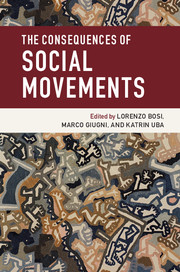Book contents
- Frontmatter
- Contents
- List of figures
- List of tables
- List of contributors
- Introduction
- Part I People
- 2 All is not lost: the 1984–85 British miners’ strike and mobilization after defeat
- 3 Personal effects from far-right activism
- 4 The biographical impact of participation in social movement activities: beyond highly committed New Left activism
- 5 Examining the intergenerational outcomes of social movements: the case of feminist activists and their children
- 6 Aggregate-level biographical outcomes for gay and lesbian movements
- Part II Policies
- Part III Institutions
- Conclusion
- Index
- References
6 - Aggregate-level biographical outcomes for gay and lesbian movements
from Part I - People
Published online by Cambridge University Press: 05 January 2016
- Frontmatter
- Contents
- List of figures
- List of tables
- List of contributors
- Introduction
- Part I People
- 2 All is not lost: the 1984–85 British miners’ strike and mobilization after defeat
- 3 Personal effects from far-right activism
- 4 The biographical impact of participation in social movement activities: beyond highly committed New Left activism
- 5 Examining the intergenerational outcomes of social movements: the case of feminist activists and their children
- 6 Aggregate-level biographical outcomes for gay and lesbian movements
- Part II Policies
- Part III Institutions
- Conclusion
- Index
- References
Summary
As social change occurs, individuals’ lives are altered. Whether produced by social movements or other forces, social change can affect the demography, life-course, and life chances of participants or of populations as a whole (Goldstone and McAdam 2001). Most empirical and conceptual work on how social movements affect biography focuses on effects on movement participants, who experience a range of lasting effects, as the introduction to this section describes. Movements can also shape biographical outcomes for the larger population, or for certain cohorts or demographics, what Guigni and McAdam (Goldstone and McAdam 2001; Guigni 2004; McAdam 1999) term “aggregate biographical outcomes.” There has been little research on aggregate-level biographical outcomes. Existing work suggests that they vary according to cohort location, spreading from activists to the general population over time, as activists develop “alternative conceptions of the life-course and related behavioral norms,” which then spread to subcultural locations such as college campuses, and finally diffuse to youth in general (Goldstone and McAdam 2001). Such life-course outcomes are generational; cohorts that have already begun trajectories of education, occupation, marriage, or childbearing are less likely to be affected by new norms. Factors such as gender and class also likely shape aggregate biographical outcomes; that is, social movements affect the life-course of different segments of the population in different ways (Hagan and Hansford-Bowles 2005; Van Dyke et al. 2000). As Guigni (2004) points out, such aggregate biographical outcomes are often unintentional.
In contrast to the previous focus on unintended effects on the general population, I focus on how social movements affect the life-course and biography of movement beneficiaries, the group on whose behalf the movement seeks change. Such effects can be intentional, although unintended effects also occur. Many social movements hope to change individuals’ lives by opening up education, job, and housing opportunities, and changing how people identify, feel, and interact (Whittier 2009). These effects can occur despite the fact that most members of beneficiary groups (such as women, African Americans, or lesbian/gay/bisexual (LGB) people) do not participate in activism on their behalf and need not agree or identify with the relevant movement. Beneficiaries are affected in different ways and through different mechanisms than activists themselves. Participants’ biographies are shaped by their immersion in activism and movement networks, collective identities, and ideological commitments; beneficiaries’ biographies are shaped by movement outcomes.
- Type
- Chapter
- Information
- The Consequences of Social Movements , pp. 130 - 156Publisher: Cambridge University PressPrint publication year: 2016
References
- 7
- Cited by



